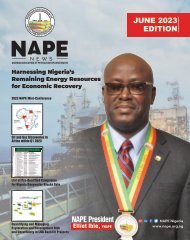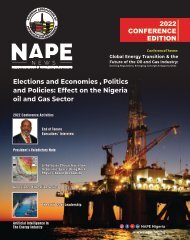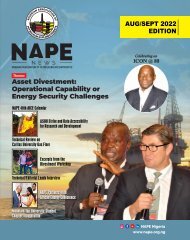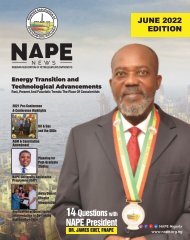Create successful ePaper yourself
Turn your PDF publications into a flip-book with our unique Google optimized e-Paper software.
obtained by sedimentological<br />
logging include rock type and<br />
textures, sedimentary structures,<br />
nature of bedding and contacts,<br />
attitudes and thicknesses of<br />
bedding, lateral extents of<br />
outcrops, as well as ichnofossils<br />
occurrence, size, degree of<br />
b i o t u r b a t i o n , e t h o l o g i c a l<br />
diversity. The data obtained were<br />
then subjected to facies analysis.<br />
T h i s a n a l y s i s i n v o l v e d<br />
identification of lithofacies, which<br />
w e r e u s e d t o i n t e r p r e t<br />
p a l a e o d e p o s i t i o n a l<br />
environments based on their<br />
a s s o c i a t i o n s . T h e s e<br />
p a l a e o d e p o s i t i o n a l<br />
e n v i r o n m e n t s w e r e t h e n<br />
reconstructed according to their<br />
order of occurrence in relation to<br />
relative sea-level changes.<br />
These reconstructions, that<br />
showed which environments are<br />
products of transgression and<br />
regression, were then used in<br />
interpreting the sequence<br />
stratigraphy of the Amasiri<br />
Sandstone Member.<br />
Figure 1: Geologic setting of the study area. (A) is a map of Nigeria showing the<br />
sedimentary basins and basement complex (modified after Obaje, 2009); (B) is<br />
a geologic map of the study area.<br />
RESULTS<br />
LITHOFACIES ANALYSIS<br />
Facies Descriptions:<br />
T w e l v e ( 1 2 ) f a c i e s a n d s i x t e e n ( 1 6 ) s u b - f a c i e s w e r e i d e n t i f i e d f r o m t h e s t u d i e d o u t c r o p s e c t i o n s i n<br />
the study area (Table 1). A summary of the facies well as their descriptions and their interpretations is thus presented (Table 1).<br />
Table 1: Summary of description and interpretation of lithofacies in the Amasiri Sandstone, Southern Benue Trough, southeastern Nigeria.<br />
Lithofacies<br />
and Facies<br />
code<br />
Conglomerate<br />
facies (G)<br />
Sub-facies<br />
G1:<br />
Horizontally<br />
stratified<br />
conglomerate<br />
G2:<br />
Planar crossstratified<br />
conglomerate<br />
G3: massive<br />
conglomerate<br />
Textures<br />
Clast-supported with<br />
coarse-grained sand matrix;<br />
poorly sorted; angular to<br />
subrounded clasts;<br />
monomictic; clast size<br />
ranges from granule to<br />
cobble.<br />
Clast-supported, very<br />
coarse-grained sand matrix<br />
with little clay;<br />
monomictic, poorly sorted,<br />
angular to rounded clasts<br />
Clast-supported, coarsegrained<br />
sand matrix with<br />
fair amount of clay;<br />
polyomictic, poorly sorted,<br />
angular to subrounded<br />
clasts<br />
Sedimentary<br />
structures<br />
Horizontally<br />
bedding<br />
Planar crossstratification<br />
Structureless,<br />
mud flasers<br />
Ichnology<br />
Not observed<br />
Not observed<br />
Not observed<br />
Depositional process<br />
Longitudinal bars, channel<br />
lag deposit, sieve deposit<br />
Linguoid bars<br />
Sediment-gravity flows or<br />
debris-falls in an environment<br />
with fluctuations in flow<br />
strength, which permits the<br />
transportation of sands in<br />
ripples followed by low<br />
energy periods where mud<br />
drapes the ripples (Boggs,<br />
2001).<br />
NAPENEWS AUG/SEPT <strong>2022</strong> 25










